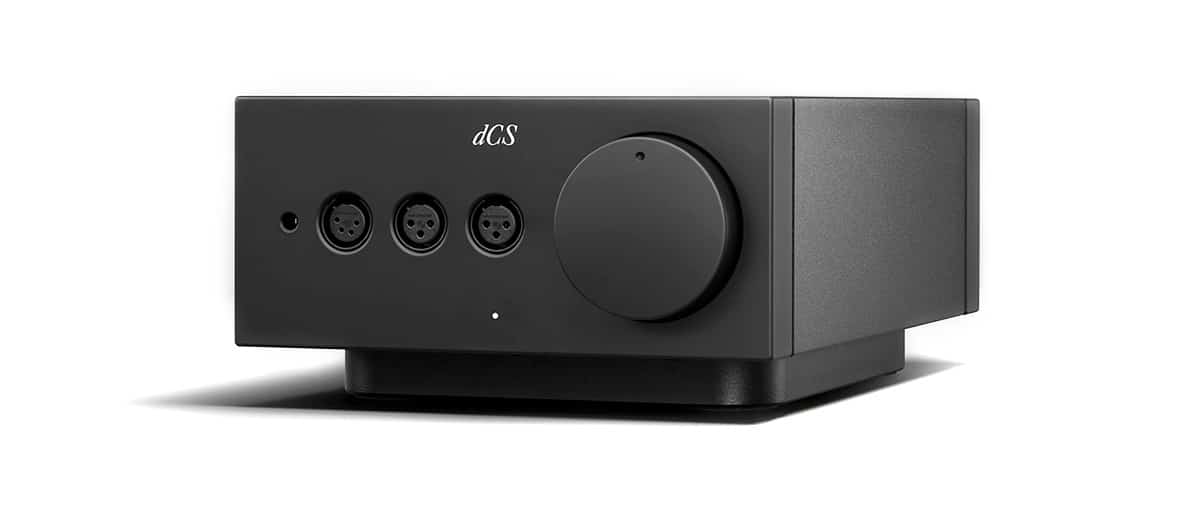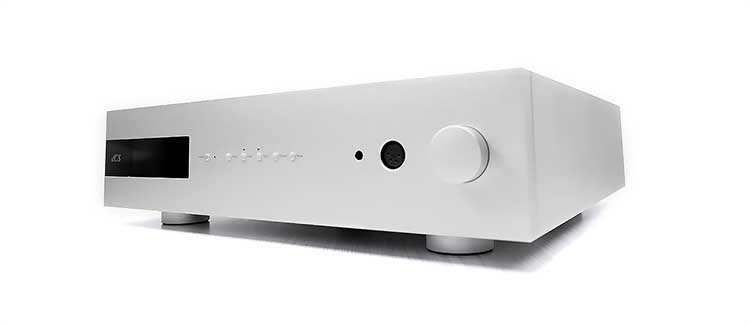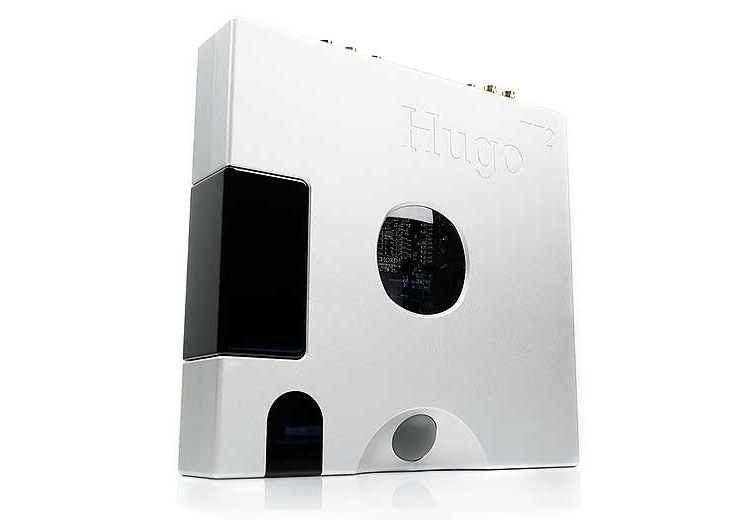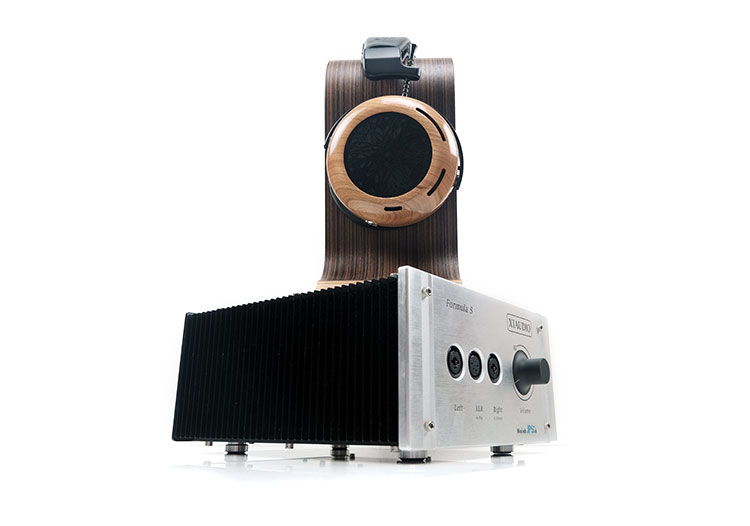Select Comparisons
All comparisons were compiled using the dCS Bartok Ring DAC and the Chord Electronics Hugo TT2 DAC output as sources with the addition of the Audeze LCD-5, Abyss Diana TC, and the T+A Solitaire P for headphone choices.
dCS Bartok
$17250
The dCS Bartok is the company’s initial foray into the headphone community and was reviewed by us in 2020. It walked away with one of our Top Gear Awards that same year.
There is a price difference for sure but then again we are talking about an integrated Network DAC, preamp, and headphone amplifier compared to the Lina amp which is a pure analog creation.
What we can do is compare like for like as in the headphone component of the Bartok compared to the Lina using the Ring DAC as the source and pre-amping to the Lina at the same time.
Technical
The biggest single difference between both amplifiers is the Class topology with the Bartok using a Class A design and the Lina amp using a Class AB.
There will be purists who will remain in the Class A camp but the reality was that the Bartok was covering a lot more areas whereas the Lina needed the dexterity and efficiency to cover all the headphone bases as it is purely a headphone amplifier.
dCS has upped the current limits as well as improved the voltage rails on the Lina over the Bartok amp to give it more headroom for trickier loads and esoteric systems such as planar which require both high current and high voltage levels.
To that end, the Lina amplifier is more powerful on paper at 2W into 30Ω compared to 1.4W (33Ω) from the Bartok when going balanced. Even on much higher loads up to 300Ω, there is still more juice on tap from the Lina at 0.48W compared to 0.15W.
Optimal output levels are also much higher on the Lina amp, (4.5W), compared to the Bartok, (2.7W), at around 60Ω which will offer more headroom to less efficient planar headphones.
I am presuming both mW measurements are A-weighted at 1kHz and we know both have sub-1Ω PO output impedance which is ideal for efficient headgear including IEMs.
One other significant technical difference in their amplification is the ability to accept 3rd party analog inputs. The Bartok is enclosed as in it can pre-amp out to any amplifier but it cannot accept an analog input from another DAC.
The Lina can not only accept a buffered input from the modular DAC equivalent but also an unbuffered higher impedance input from just about any 3rd party DAC SE or balanced.
Design
The Bartok is a lot bigger and heavier than the Lina amplifier. The form factor is also much wider and deeper making the not insubstantial Lina seem rather compact.
One must remember, however, that the Bartok is packing both an amp, pre-amp, and network DAC, and to get that level of functionality with the Lina you have to add the DAC at the very least which brings the comparative weight to almost the same level, 15kg for both Lina components together compared to 16.7kg for the Bartok.
Despite the color variation we have for our samples the design language itself is not hugely different. The main differences are largely due to the DAC integration requiring a lot more onboard control and information display which is now shifted to the Lina DAC.
The interface on the Lina amp is a lot more minimalistic with no front fascia labeling and a much bigger potentiometer dial. Both pots are very smooth with good control but I slightly prefer the grippier matte texture of the Lina dial for day-to-day use.
Any controls on the Lina are lower profile and positioned under the front fascia including power on and the two-stage gain. Bartok actually has more gain stages but 10dB of that gain is DAC driven and 20dB is done via the amp itself through the main menu system.
The PO I/O on the Lina amp is more comprehensive with additional left/right balanced XLR outputs as well as matching the Bartok for balanced 4-pin and 6.35mm SE outputs. I do still feel the lack of a 4.4mm on the Lina amp is a missed opportunity in this modern era.
Performance
For this comparison, I opted for the 6V preamp output setting from the Bartok Ring DAC to the Lina amp and started with the Abyss Headphones Diana TC. These have a load rating that should suit the optimal power potential from both amplifiers in balanced mode at 69Ω and 90dB SPL.
Splitting the two amps between technical and timbral, the Lina amp has a bit more in terms of dynamic range and pinpoint accuracy but the Bartok amp is a smoother and slightly denser presentation, at least on the low-end. The former is a certain improvement for planar headphones, the latter could be one of pure preference.
Technical
I suspect the additional headroom of the Lina amp delivers that dynamic range advantage but it is not night and day differences. You tend to hear it more in just how responsive the low-end is and it does portray a class AB punchy sound whereas the Bartok has that slightly smoother feel to the low-end that I tend to equate with Class A amplifiers.
With the Diana TC, the imaging feels more upfront and dynamic in its delivery using the Lina pairing. It feels precise, quick in its transient response, and quite vivid, especially through the midrange and vocal performances.
The Bartok is a little more bottom-heavy though still with a strong vocal image using the Diana TC. However, rather than an upfront performance, the surrounding instrumental imaging placement is a little more dispersed in the delivery creating a roomier but more relaxed staging perception.
One thing to note, despite the stronger density of the Bartok and fuller low-end, I actually felt the Lina extended a bit more with the TC, just not with the same amount of body.
Timbre
I think some of that perception is also tainted by the coloration. The timbre from the Bartok is somewhat warmer, more even-harmonic biased with richer color and plenty of detailed texture.
Treble is less forward sounding and more graceful which in turn, creates a slightly sweet overtone into the mids though nuanced rather than overt. Leading edges and decay lengths tend to be more liquid than dry which in turn creates a nice mix of weight and a natural ‘undistilled’ timbre.
The Lina feels more precise, more neutral, and snappier. The treble presence levels are increased but not to the point where it becomes bright or unnatural sounding. However, the decay does shorten up a little placing more emphasis on core strengths that the Diana TC loves; transient response speed and highlighting note leading edges.
Chord Electronics Hugo TT2
£3995
Sadly, we do not have the Dave to compare, however, we can look at the TT2 rig as the next best offering with both winning awards in 2020 and 2021.
Like the Bartok comparisons, the TT2 is much more than a pure headphone amplifier with its own in-house DAC, pre-amp, and modular expansion capability to incorporate other Chord devices such as the M Scaler.
In this instance, we will use the TT2 as our source DAC feeding an analog out to the Lina amplifier in order to compare its performance against the built-in TT2 amplifier.
Technical
Chord is somewhat frugal when it comes to exactly what circuitry is inside their actual TT2 amplifier compared to dCS which is quite upfront about the Lina amp using a Class AB design.
What we do know is that it is discrete engineered and supplies varying levels of power to both the preamp and headphone amp PO rather than separate components for either.
It also uses a discreet output stage between the internal DAC and filter and before the amplifier to reduce potential distortion whereas the Lina uses its unique DC servo system for error and distortion control within its AB circuit.
Perhaps, more importantly, is that the TT2 on the headphone side is single-ended by design and does not have a balanced PO capability that the Lina does offer. You could argue the choice of PO is excellent though with not just 1 SE output but 3 including a single 3.5mm and two 6.35mm alternatives.
So, if we are rating them side by side on their SE performance on paper the Lina is a little lower officially at 1.6W into 30Ω compared to 2.7W into 32Ω from the TT2.
Going balanced, again on paper, it’s 2W into 30Ω from the Lina but you have to remember that the optimal level of the Lina amp is closer to 60Ω which will yield a higher potential of up to 4.5W of power.
Design
Well, no question about which amplifier is the lighter and more compact. That will be the Hugo TT2 weighing in at around 2.5kg compared to the heftier 7.5kg of the Lina amplifier.
It is also a lower profile with fairly diminutive dimensional measurements so tiny spaces are its friend though the shoebox style of the Lina will be too demanding of rack space either.
Both are modular units with the TToby and the Hugo M Scaler all part of an integrated stack similar to Lina’s amp, DAC, and Master Clock. However, the pitch is quite different with the Chord stack more for desktop quality HiFi and the Lina stack still resolutely functioning as a high-end headphone system.
Aesthetically, very contrasting in the design language. The Chord is somewhat asymmetrical appearances-wise with a mix of see-through ports in the middle, shaded antennae windows, and LCD panels to the left also. It is stylistic but nevertheless a busy interface given you have control of not just an amp but also a DAC and preamp.
The dCS Lina amplifier is much more minimalist, both in operational simplicity and aesthetical appearance. And to be honest, the entire Lina modular stack follows suit looking far less busy, especially when everything is switched off.
One thing to mention is Chord’s orb color control system. Whilst the LCD menu system does help, it is nevertheless a steeper learning curve than the classic rotary pot control of the Lina amplifier. Aside from the simple gain and power switch discreetly positioned underneath there is a much lower learning curve here.
Chord does supply a physical remote control which would have been nice for the Lina amplifier to have if you are not buying the Lina DAC which syncs with the Mosaic app for controls.
Pairing
I decided to go with the LCD-5 for this comparison using the stock 6.35mm cable primarily because driving it is not an issue be it balanced or SE from these two amps.
Also, the LCD-5 FR is fairly neutral on the lows and strong in the upper mids so I was curious to see how well each amp coped with both aspects. Given they are running from the same DAC I was not expecting too much difference in terms of resolution so what I was looking for here is dynamic range and coloration.
Performance
What I got was a big difference in the fundamentals from both amps with the LCD-5. The Hugo TT2 is a little thicker and weightier if the music is more focused on the upper bass to lower mids whereas I find the Lina amp to be more neutral and linear in both tonal quality and imaging.
You will hear that mostly with most bass guitar texture and presence where you could argue that the Lina keeps it very reference sounding and the TT2 adds a bit more euphony and warmth.
However, drop a little lower, say bass synth, kick drums, and massive orchestral drums that reach down way below 100Hz, then the rumble and power of the Lina/LCD-5 pairing are much stronger. I say this though when it is called upon, it is not omnipresent which makes it all the more noticeable when it kicks in.
That is a big change in the dynamic for me between both amplifiers. It creates a lot more potential for depth and improved PRaT in the soundstage from the Lina compared to the TT2. The Lina really ups the harmonic lower order giving each uber-low pitching note a more robust authoritative quality.
The TT2 mids have a more forward feel to them and it’s where you tend to focus more on given the head gain on the LCD-5 is naturally high in that area also. The Lina is more neutral in both imaging and coloration and can sound slightly narrower as a result. It doesn’t spray imaging cues quite as wide.
However, the additional sub-bass weight creates a bit more stretch in the staging quality whereas the TT2 focuses a lot more on mids width with a mix of height and sparkle thrown in.
XI Audio Formula S
The XI Audio Formula S is one of our long-standing favorite solid-state amplifiers for comparisons here. reviewed in 2018 and a Top Gear Award winner that same year also.
$3,899
Technical
The Formula S, like the Lina amplifier, is a pure analog headphone amplifier. However, Formula S uses a single-ended Class A discrete engineered BJT topology or a Bipolar Junction Transistor which is current-controlled as opposed to something like a MOFSET which is voltage-controlled.
The choice of amplification for XI Audio came down to rating BJT bipolar resistors as better amplifier parts than the FET equivalents to allow them to achieve the specific type of tuning they wanted for the Formula S. The downside is that the design is more energy-consuming and probably not as efficient as the Lina.
In some ways, dCS went down a similar route in choosing a Class AB topology. Primarily, in terms of producing an amplifier that can cope with voltage and current demands of a very wide range of headgear whilst at the same time retaining the renowned house sound of a dCS audio component.
The Formula S is capable of a single-ended output rating of 2.1 watts into 46Ω which is a competitive rating compared to the balanced output peak rating of 1.6W into 30Ω from the Lina.
However, at 2W into 30Ω ranging up to 4.5W at 60Ω the balanced output of the Lina seems likely to be more powerful with improved voltage and current headroom at a similar 46Ω rating for demanding planar headphones.
Design
Both amplifiers retain a fairly traditional ‘HiFi’ shape and the weight is not too far off each other at 5kg versus 7.5kg. However, for me, that is where the similarities end aesthetically speaking.
The Lina amplifier finishing is on another level looking far sleeker, more integrated with nuts and bolts invisible to the naked eye. The Formula S is sturdy, built like a tank, and striking in its own way but has more of a DIY feel to its finishing. It looks like an old-school amplifier in a way.
Options on the PO side might seem similar but they are not. The Lina is a balanced headphone amplifier so its range of XLR options are genuinely balanced outputs. The XLR on the Formula S is for varying preferences but will still deliver a single-ended output alongside the 6.35mm socket.
On the rear, the Formula S options are more limited with a single set of dual-RCA SE inputs and a single gain switch offering a 6dB swing as opposed to 10dB with Lina’s own gain switch housed discreetly on the front panel.
One thing you do have with the Formula S is a circular expansion 7-pin power supply connector that connects to XI Audio’s Powerman. This is a modular high current discrete power supply and stacks neatly under Formula S. I am not sure that the Lina needs that to be honest but sadly, I cannot say what the advantages sound like as we do not have one here.
Pairing
I decided to go with the T+A Solitaire P for this particular review for a few reasons. The first is that whilst SPL is not an issue at 100dB, its 80Ω rating might give me some more insight into Lina’s power curve compared to Formula S.
The second is that since Formula S is a single-ended amplifier I wanted to match like for like. The Solitaire P sample we have comes with 4.4mm and 6.35mm only making it a suitable candidate. The final is the Solitaire P’s 7-10k treble peak which can make it a slightly fussy pairing if the amplifier and source do not get a solid grip on it.
Performance
The immediate impression of the difference between these two amplifier performances with the Solitaire P was that of the word ‘calm’.
The Lina amplifier came across as the slightly smoother, more robust sounding amplifier with a calmer top-end whereas the Formula S was more ethereal, more dispersed, and the brighter of the two for the Solitaire P highs.
You could argue that the Lina was the more reference sounding of the two pairings, or perhaps not as treble forward and shimmery in its delivery through the treble and consequently the mids timbre to some extent. It certainly seems that the Formula S tuning amplifies the Solitaire P upper FR peaking to a greater extent.
Either way, the Formula S felt the busier of the two pairings for the upper mids and treble creating a little more contrast between what I would loosely describe as a more ‘elastic’ bass response and a slightly lighter-bodied midrange performance.
The Lina sounded just right, felt controlled, more physical, and direct in the Solitaire P lows, more evenly balanced through the mids, and slightly softer on the highs. The resulting performance might not be as airy but sounded fuller, more authoritative, and with slightly less dissonance crossing over into percussion and vocal timbre.
Of course, the ace card for the Lina is the ability to go balanced so if we are speaking in terms of dynamic range I felt both were quite competitive going SE. However, you will get a superior level of channel separation and improved dynamic range from the additional power of the Lina balanced output.
Our Verdict
It can be quite difficult to reference and talk about the amplifier alone without reference to the performance when combined with the additional components that make this a complete system. And yet, at the same time the world-class performance of the DAC and the Master Clock would all be nothing if the amp was in any way lacking.
In that sense, the dCS Lina headphone amplifier is the perfect high-performing partner to its siblings. It’s tastefully neutral, very revealing and with enough power to drive every headphone I tested with it. It manages to combine reference level accuracy with an almost perfect harmonic balance to prevent this from ever sounding analytical.
I would still call this a pure ‘headphone amplifier’ though. IEMs, particularly sensitive ones, are still not quite right with this setup unless they are more demanding for power. It is an improvement though from the Bartok so the flexibility for pairing an in-ear is much stronger.
Overall, from a planar headphone fan, this is a tremendously satisfying and engrossing world-class solid-state amplifier and if you have the moolah to buy it I will be a very jealous guy but a happy one for you at the same time.
dCS Lina Headphone Amplifier Specifications
- Dimensions / Weight 121.5mm (H) x 220mm (W) x 356mm (D) / 7.5kg
Headphone Outputs
- 1 x dual 3-pin balanced XLR, right and left channel
- 1 x single 4-pin balanced XLR
- 1 x single 1⁄4” (6.35mm) headphone jack
- Signal to Noise Ratio 110dB 20Hz-20kHz A-weighted (referenced to 6V RMS balanced input and output)
Power Output
- 2 x Balanced 2W into 30Ω
- 2 x Balanced 0.48W into 300Ω
- 2 x Unbalanced 1.6W into 30Ω
- 2 x Unbalanced 0.2W into 300Ω
Analog Inputs
- 1 x stereo pair unbalanced RCA, input impedance 48kΩ
- 1 x stereo pair unbuffered balanced XLR, input impedance 16kΩ
- 1 x stereo pair buffered balanced XLR, input impedance 96kΩ
- THD+N <0.005% @ 1kHz 6V RMS balanced output into 30Ω (80kHz bandwidth)
- Frequency Response 1Hz-100kHz Better than +0/-3dB








